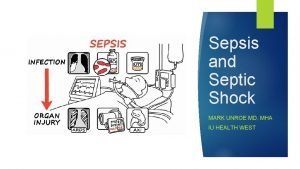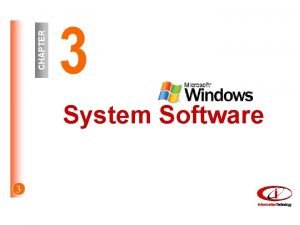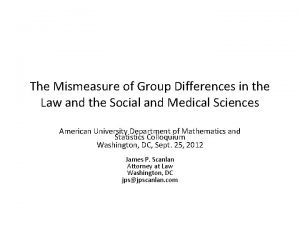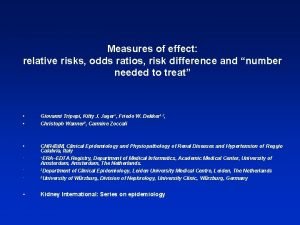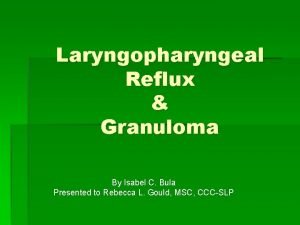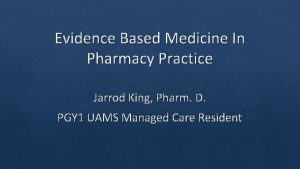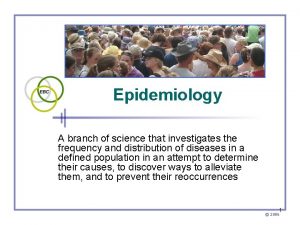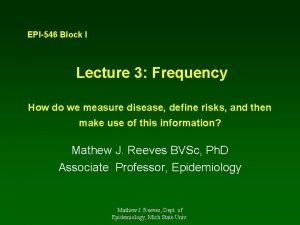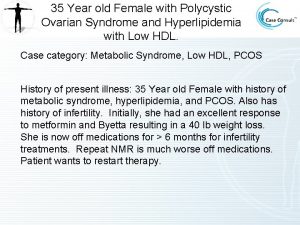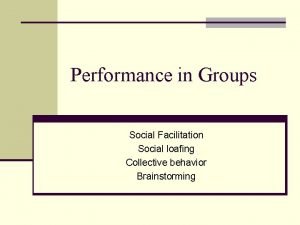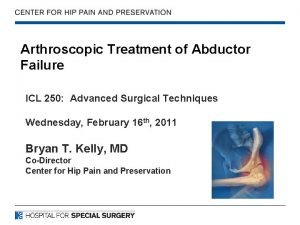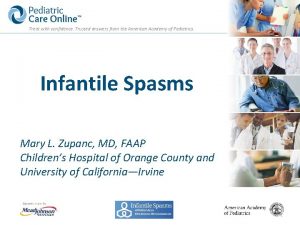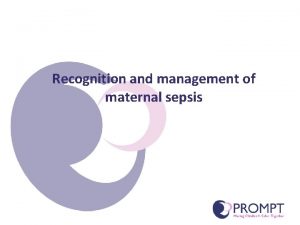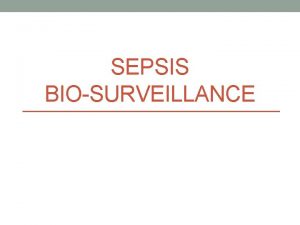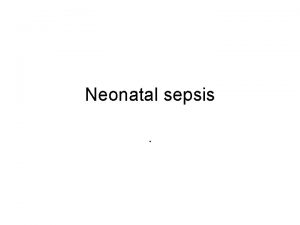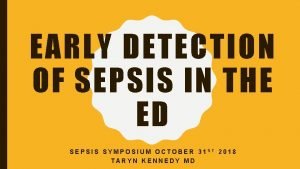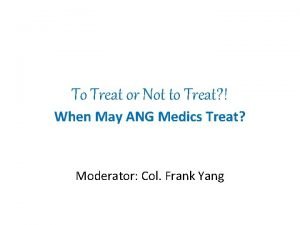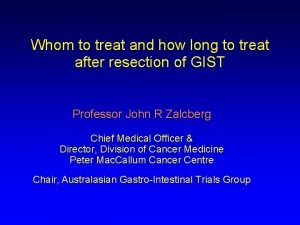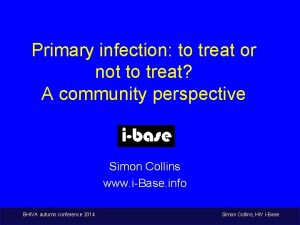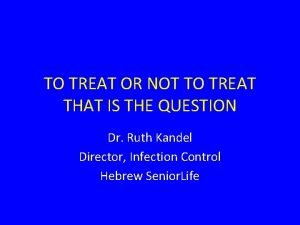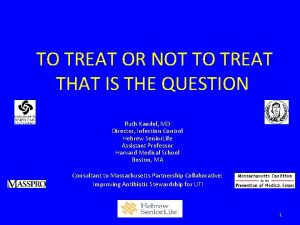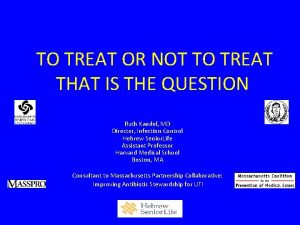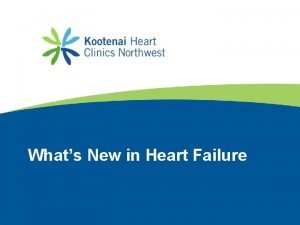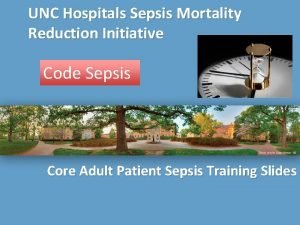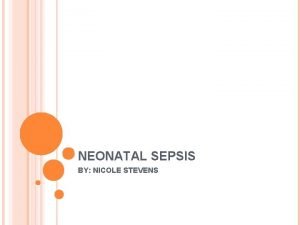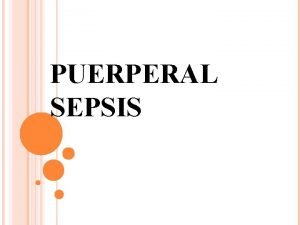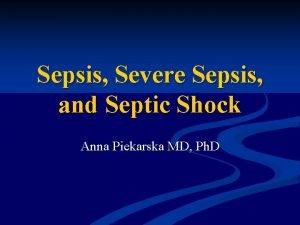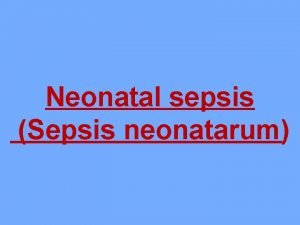Sepsis Program Development Recognize Sepsis Early Treat Early








































![References • http: //www. mnhospitals. org/quality-patient-safety-initiatives/sepsisand-septic-shock/#/videos/view/39 [cited 2017 Sep 21]. • Rick Chou, D. References • http: //www. mnhospitals. org/quality-patient-safety-initiatives/sepsisand-septic-shock/#/videos/view/39 [cited 2017 Sep 21]. • Rick Chou, D.](https://slidetodoc.com/presentation_image_h2/60c692d2b83ceaf35c29871f1a57fc65/image-41.jpg)

- Slides: 42

Sepsis Program Development Recognize Sepsis Early Treat Early Patricia Howell RN, BSN, WCC Clinical Support Manager Mc. Kesson Medical Surgical

OBJECTIVES 1. Identify causes of sepsis in the post-acute setting. 2. Understanding signs and symptoms of sepsis for early recognition and reduction of hospital re-admission. 3. Discuss prevention and treatment approaches of sepsis for treating resident in your facility. 2 6/9/2021 Mc. Kesson Proprietary and Confidential

CDC's updated stats are showing 3 6/9/2021 Mc. Kesson Proprietary and Confidentia cdc. govl

National Statistics Ø Sepsis is the leading cause of death in U. S. hospitals. Ø 62% of people hospitalized with sepsis are re-hospitalized within 30 days. Ø As many as 92% of sepsis cases originate in the community. Ø Mortality from sepsis increases 8% for every hour that treatment is delayed. Ø As many as 80% of sepsis deaths could be prevented with rapid diagnosis and treatment. 4 6/9/2021 Mc. Kesson Proprietary and Confidential Sepsis. org

Most Expensive Conditions Treated in Hospitals in 2013 5 6/9/2021 Mc. Kesson Proprietary and Confidential Tori, C. et al

Identify causes of sepsis in the post-acute setting • Sepsis is the most common admitting diagnosis for patients that are transferred to hospitals from many skilled nursing facilities. • Certain patients at increased risk include adults 65 and older, people with chronic medical conditions such as diabetes, lung and kidney disease and cancer. • People with weakened immune systems and children younger than one are also considered more at risk. • The most frequently identified pathogens that cause infections that can develop into sepsis include Staphylococcus aureus (staph), Escherichia coli (E. coli), and some types of Streptococcus (strep). 6 6/9/2021 Mc. Kesson Proprietary and Confidential Rick Chou, D. O.

Identify causes of sepsis in the post-acute setting • Four types of infections that are often linked with sepsis v. Lung (respiratory/pneumonia) secondary complication of flu is pneumonia, v. Urinary UTI v. Skin and wound in LTC patients, vand gut. 7 6/9/2021 Mc. Kesson Proprietary and Confidential Mc. Kesson Sepsis Resource Guide

8 6/9/2021 The word "sepsis" was first introduced by Hippocrates (ca. 460370 BC) and is derived from the Greek word sipsi ("make rotten"). Mc. Kesson Proprietary and Confidential http: //www. sepsisgesellschaft. de/DSG/Englisch/Disease+pattern+of+Sepsis/Sepsis+History

What is Sepsis? • Sepsis is a life threatening organ dysfunction caused by a dysregulated host response of infection. • As part of the body’s inflammatory response to fight infection, chemicals are released into the bloodstream. These chemicals can cause blood vessels to leak and clot, meaning organs like the kidneys, lung, and heart will not get enough oxygen. The blood clots can also decrease blood flow to the legs and arms leading to gangrene. • Septic shock is defined as a subset of sepsis that is profound enough to substantially increase mortality over sepsis alone 9 6/9/2021 Mc. Kesson Proprietary and Confidential cdc. gov/sepsis

Identification of Sepsis 10 6/9/2021 Mc. Kesson Proprietary and Confidential qsofa. org

q. SOFA (Quick Sepsis Related Organ Failure) Score 11 6/9/2021 Mc. Kesson Proprietary and Confidential

Progression of Sepsis 12 6/9/2021 SIRS SEPSIS SEVERE SEPSIS Screen Treat Transfer Mc. Kesson Proprietary and Confidential SEPTIC SHOCK

SIRS (Systemic Inflammatory Response Syndrome) • Widespread inflammatory response to microbial invasion or cell injury • May or may not be due to infection • Signs & Symptoms: ü Fever or hypothermia, ü Tachycardia, ü Tachypnea, ü Leukocytosis or leukopenia 13 6/9/2021 Mc. Kesson Proprietary and Confidential

SIRS Criteria Temp > 100. 0 or <96. 8 WBC >12, 000 or <4000 or 10% bands Heart Rate/BP >90 BP <100 or > 40 mm. Hg from baseline Resp Rate >20/Sp. O 2 , 90% • If patient’s numbers are noted to be at baseline for particular residents, then change HR > 110 and RR > 25 • If concerned that this is baseline (patient has spikes), recheck in 30 min and notify if still elevated 14 6/9/2021 Mc. Kesson Proprietary and Confidential http: //www. mnhospitals. org

Example of Sepsis Protocol in the SNF Diagnosis Infection – Pre – Sepsis 1) Typical Symptoms WBC > 12 K or < 4 K Temp > 100. 4 or < 96. 8 2) Clinical diagnosis of infection based on atypical symptoms q. SOFA Criteria 1) Change in mental status(neuro) 2) RR > 20 3) Systolic BP < 100 mm Hg or systolic BP fall > 40 mm Hg Infection + 2 q SOFA Criteria = SEPSIS 15 6/9/2021 http: //www. mnhospitals. org

Example of Sepsis Management in the SNF Intermediate Interventions Begin treatment ASAP within 1 hour Infection – without sepsis (pre – sepsis) Begin Level 1 Treatment 1) Start PO Antibiotics 2) Perform CBC w diff, BMP, CXR and urine C&S if needed 3) Follow-up within 24 hrs for treatment response If Sepsis, perform Level 1 Treatment 1) Obtain bld culture, CBC/BMP (don’t delay treatment for lab/culture results) 2) Place IV and begin antibiotics 3) Administer 500 cc NS IV bolus then start 250 ml/hr then run at 100 ml/H to 2 liters (If heart failure diagnosis verify fluid rate w HCP) 4) Perform CSR or urine C&S (if needed) 5) Follow-up in 24 hrs for treatment response, 16 6/9/2021 http: //www. m nhospitals. or g order vitals q 4 h

Post-Acute Care Early Identification and Treatment of Sepsis Pathway 17 6/9/2021 Mc. Kesson Proprietary and Confidential improvesepsis@tmf. org

Post-Acute Care Early Identification and Treatment of Sepsis Pathway Mc. Kesson Proprietary and Confidential 18 6/9/2021 improvesepsis@tmf. org

Mc. Kesson Proprietary and Confidential 19 6/9/2021 Understanding signs and symptoms of sepsis for early recognition and reduction of hospital re-admission.


Signs and Symptoms of Sepsis Ø Symptoms: Just don’t look right. Resident weak, more confused, and have other symptoms of infection ü ü 21 6/9/2021 Urinary Tract = frequency, urgency, burning on urination, or pain Respiratory = cough, shortness of breath, increase in sputum Skin = draining wound, redness, swelling, and warm to touch Neurologic = confusion, headache, stiff neck and sensitivity to light Mc. Kesson Proprietary and Confidential

Early recognition signs: Initiate the 100, 100 rule staff screen 22 6/9/2021 Mc. Kesson Proprietary and Confidential

Prevent Hospitalization: Initial Management Based off Level of Care and Ability • Your goal in the nursing home is to do everything you can to avoid septic shock • Early recognition and early antibiotic administration and fluid resuscitation • Check patient progress frequently. Reassess antibiotic therapy 24 -48 hours to stop or change therapy as needed. Be sure antibiotic type, dose, and duration are correct. Mc. Kesson Proprietary and Confidential 23 6/9/2021 cdc. gov/sepsis

The Relationship of Infection Prevention to Sepsis and Antimicrobial Stewardship • To reduce the chances of employing broad spectrum antibiotics for sepsis, prevent infections from occurring in the first place. • To reduce the chances of acquiring multi-drug resistant pathogens, which makes treatment of sepsis more challenging, emphasize infection control measures. 24 6/9/2021 Mc. Kesson Proprietary and Confidential

Antimicrobial Stewardship • To promote the appropriate use of antimicrobials and combat antimicrobial resistance, the surviving sepsis campaign recommends that empiric antimicrobial therapy be narrowed once pathogen identification and sensitivities are established and/or adequate clinical improvement is noted. • The surviving sepsis campaign also recommends that an antimicrobial treatment duration of 7 -10 days is adequate for most serious infections associated with sepsis and septic shock. 25 6/9/2021 Mc. Kesson Proprietary and Confidential surviving sepsis campaign

Antimicrobial Therapy • • 26 Start P. O. Antibiotics if infection without sepsis (pre-sepsis) Empiric broad-spectrum IV antimicrobial therapy initiated as soon as possible when sepsis or the risk of sepsis is identified 6/9/2021 Mc. Kesson Proprietary and Confidential

Educate Patients (and their Families) About Infection Prevention, Antibiotic Stewardship & More • • 27 The informed patient is more likely to be adhere with therapy, and can assist in preventing infection and understand when antibiotics are needed - and when they are not. The informed family member can also learn how to prevent infection. 6/9/2021 Mc. Kesson Proprietary and Confidential

Developed and validated sepsis screening tools generally evaluate three areas: 1. Known or suspected infection 2. Systemic manifestations: – Hyperthermia or hypothermia – Tachycardia – Tachypnea – Acute mental status change – Leukocytosis or leukopenia – Hyperglycemia 28 6/9/2021 Mc. Kesson Proprietary and Confidential Dellinger, et al. 3. New or worsened organ dysfunction: – Hypotension – Increasing oxygen requirements – Elevated lactate, creatinine, bilirubin level – Thrombocytopenia – Coagulopathy

What can be done to prevent Sepsis? • • Make sure you, your staff, visitors and resident’s WASH THEIR HANDS How to engage people to wash their hands: – – 29 Make hand hygiene a topic of conversation with your residents Address hand hygiene before you begin your care Explain how and why you clean your hands before, after, and sometimes during patient care. THANK THEM FOR BEING ENGAGED IN THEIR CARE 6/9/2021 Mc. Kesson Proprietary and Confidential CDC. gov/Hand. Hygiene

Get your flu shot- encourage staff, residents and families get vaccinated against the flu 30 6/9/2021 Mc. Kesson Proprietary and Confidential cdc. gov

What else can you do to prevent Sepsis? Encourage residents over the age of 65 to the pneumonia vaccine 31 6/9/2021 Mc. Kesson Proprietary and Confidential Infection Education Infection Prevention Antimicrobial Stewardship

Patient Teaching for prevention 32 6/9/2021 Mc. Kesson Proprietary and Confidential

Patient Teaching for prevention 33 6/9/2021 Mc. Kesson Proprietary and Confidential

Patient Teaching for prevention 34 6/9/2021 Mc. Kesson Proprietary and Confidential

Recovery: • Many individuals fully recover from sepsis, • Many others are left with long-lasting effects, such as missing limbs or organ dysfunction, like kidney failure. • Other after-effects of sepsis are less obvious, such as memory loss, anxiety, or depression. 35 6/9/2021 Mc. Kesson Proprietary and Confidential

Minnesota Hospital Association (MHA) • MHA – developed LTC-specific Seeing Sepsis Tool Kit • MHA’s LTC resources –Seeing Sepsis cards and posters that alert the user to notify the nurse to screen for sepsis if – the resident’s temperature is higher than 100° F, – heart rate is greater than 100 beats per minute, and/or – systolic blood pressure is lower than 100 mm. Hg and the resident “doesn’t look right” • Act Fast document for LTC – same screening alerts plus next steps for medical providers in the event of a positive sepsis screen Mc. Kesson Proprietary and Confidential 36 6/9/2021 http: //www. mnhospitals. org

Questions and Thoughts? 37 6/9/2021 Mc. Kesson Proprietary and Confidential

Thank You! Patti Baicy RN, CNOR(E) Director of Clinical patti. baicy@mckesson. com Mc. Kesson Clinical Connection 877. 611. 0081 or visit mms. mckesson. com/mckesson-clinical-connection The information contained in this complimentary webinar. Mc. Kesson makes no representations or warranties about, and disclaims all responsibility for, the accuracy or suitability of any information in the webinar and related materials; all such content is provided on an “as is” basis. MCKESSON FURTHER DISCLAIMS ALL WARRANTIES REGARDING THE CONTENTS OF THESE MATERIALS AND ANY PRODUCTS OR SERVICES DISCUSSED THEREIN, INCLUDING WITHOUT LIMITATION ALL WARRANTIES OF TITLE, NON-INFRINGEMENT, MERCHANTABILITY, AND FITNESS FOR A PARTICULAR PURPOSE. The content of webinar and related materials should not be construed as legal advice and is intended solely for the use of a competent healthcare professional. Eligibility Requirements For Participating in a Mc. Kesson Webinar: This webinar is not open to the general public. Your participation in this webinar cannot be transferred or assigned to anyone for any reason. You do not have to be a current customer of, purchase products from, or be affiliated with, Mc. Kesson, in order to participate in the webinars. Mc. Kesson, in its sole discretion, may terminate this promotion at any time. Due to certain regulatory restrictions, this promotion cannot be offered to health care providers licensed in Vermont and/or to government employees.

References • Dellinger RP, Levy MM, Rhodes A, et al. Surviving sepsis campaign: international guidelines for management of severe sepsis and septic shock: 2012. Crit Care Med 2013 Feb; 41(2): 580 -637. • Minnesota Hospital Association. Seeing sepsis: early identification saves lives [Seeing Sepsis Long Term Care Resources online]. [cited 2016 Feb 10]. Available from Internet: • http: //www. mnhospitals. org/patient-safety/current-safety-qualityinitiatives/severe-sepsis-and-septicshock • T Welty. Sepsis history [website]. [cited 2017 Sep 20]. Jena, Germany: German Sepsis Society. Available from Internet: http: //sepsisgesellschaft. de/DSG/Englisch/Disease+pattern+of+Sepsis/Sepsis+History? iid=2 • Christine Kilgore, Evolving Sepsis Criteria and New Management Guidelines Hold Lessons for PA/LTC. [cited 2017 Sep 20] DOI: http: //dx. doi. org/10. 1016/j. carage. 2017. 06. 007 • Rick Chou, D. O. Optum Medical Director – Complex Population Management, EARLY Recognition & Treatment of Sepsis in the Skilled Nursing Facility [cited 2017 Sep 20]. Available from Internet: https: //www. hanys. org/etta/include/docs/sepsis_slides. pdf 39 6/9/2021 Mc. Kesson Proprietary and Confidential

References • Angus DC, Linde-Zwirble WT, Lidicker J, et al. Epidemiology of severe sepsis in the United States: analysis of incidence, outcome, and associated costs of care. Crit Care Med 2001; 29(7): 1303 -10. • Ginde AA, Moss M, Shapiro NI, et al. Impact of older age and nursing home residence on clinical outcomes of U. S. emergency department visits for severe sepsis. J Crit Care 2013 Oct; 28(5): 606 -11. • http: //www. sepsisgesellschaft. de/DSG/Englisch/Disease+pattern+of+Sepsis/Sepsis+History [cited 2017 Sep 21]. 40 6/9/2021 Mc. Kesson Proprietary and Confidential
![References http www mnhospitals orgqualitypatientsafetyinitiativessepsisandsepticshockvideosview39 cited 2017 Sep 21 Rick Chou D References • http: //www. mnhospitals. org/quality-patient-safety-initiatives/sepsisand-septic-shock/#/videos/view/39 [cited 2017 Sep 21]. • Rick Chou, D.](https://slidetodoc.com/presentation_image_h2/60c692d2b83ceaf35c29871f1a57fc65/image-41.jpg)
References • http: //www. mnhospitals. org/quality-patient-safety-initiatives/sepsisand-septic-shock/#/videos/view/39 [cited 2017 Sep 21]. • Rick Chou, D. O. Early Recognition & Treatment of Sepsis in the Skilled Nursing Facility. https: //www. hanys. org/etta/include/docs/sepsis_slides. pdf [ cited Sep 20, 2017] 41 6/9/2021 Mc. Kesson Proprietary and Confidential

Thank You! • Patricia Howell RN, BSN, WCC • Patricia. howell@mckesson. com Mc. Kesson Clinical Connection™ call us at 1 -877 -611 -0081 Unless otherwise noted, the recommendations in this document were obtained from the sources noted on the reference pages and ASPEN. Be advised that information contained herein is intended to serve as a useful reference for informational purposes only and is not complete clinical information. This information is intended for use only by competent healthcare professionals exercising judgment in providing care. Mc. Kesson cannot be held responsible for the continued currency of or for any errors or omissions in the information. This webinar has been provided to participants on a complimentary basis. Mc. Kesson makes no representations or warranties about, and disclaims all responsibility for, the accuracy or suitability of any information in the webinar and related materials; all such content is provided on an “as is” basis. MCKESSON FURTHER DISCLAIMS ALL WARRANTIES REGARDING THE CONTENTS OF THESE MATERIALS AND ANY PRODUCTS OR SERVICES DISCUSSED THEREIN, INCLUDING WITHOUT LIMITATION ALL WARRANTIES OF TITLE, NON-INFRINGEMENT, MERCHANTABILITY, AND FITNESS FOR A PARTICULAR PURPOSE. The content of webinar and related materials should not be construed as legal advice and is intended solely for the use of a competent healthcare professional. Eligibility Requirements For Participating in a Mc. Kesson Webinar: This webinar is not open to the general public. Your participation in this webinar cannot be transferred or assigned to anyone for any reason. You do not have to be a current customer of, purchase products from, or be affiliated with, Mc. Kesson, in order to participate in the webinars. Mc. Kesson, in its sole discretion, may terminate this promotion at any time. Due to certain regulatory restrictions, this promotion cannot be offered to health care providers licensed in Vermont and/or to government employees.
 How do we treat the life the life how we treat
How do we treat the life the life how we treat Sepsis 2 vs sepsis 3
Sepsis 2 vs sepsis 3 How does katniss react to peeta’s declaration of love?
How does katniss react to peeta’s declaration of love? The organization of ideas
The organization of ideas Skill 2 recognize the organization of ideas
Skill 2 recognize the organization of ideas How many countries recognize palestine
How many countries recognize palestine Entrepreneurship chapter 1
Entrepreneurship chapter 1 Conflict theory criminology
Conflict theory criminology Chronic hyperplastic candidiasis
Chronic hyperplastic candidiasis Lars didn't recognize patrick logan because
Lars didn't recognize patrick logan because Cones and rods are to vision as ____ are to audition
Cones and rods are to vision as ____ are to audition Resolution 435 s. 1997
Resolution 435 s. 1997 3 system software
3 system software Are all the materials useful
Are all the materials useful Leading coefficient
Leading coefficient Refusing to recognize an emotion or problem
Refusing to recognize an emotion or problem How does the lieutenant recognize beowulf as a hero?
How does the lieutenant recognize beowulf as a hero? Treaty 6
Treaty 6 Cambysus
Cambysus Equation for number needed to treat
Equation for number needed to treat Invitation to treat
Invitation to treat What does juliet say she would rather do than marry paris
What does juliet say she would rather do than marry paris Which seedless plants have been used to treat bee stings
Which seedless plants have been used to treat bee stings Number needed to treat calculation
Number needed to treat calculation Offer
Offer Laryngopharyngeal reflux (
Laryngopharyngeal reflux ( Calculate number needed to harm
Calculate number needed to harm Number needed to treat formula
Number needed to treat formula Interpreting relative risk
Interpreting relative risk Number needed to treat
Number needed to treat Guthing vs lynn case
Guthing vs lynn case Number needed to treat formula
Number needed to treat formula Fisher v bell literal rule
Fisher v bell literal rule Treat everyone with sincerity
Treat everyone with sincerity Act 2 scene 4 romeo and juliet
Act 2 scene 4 romeo and juliet Is byetta used to treat pcos
Is byetta used to treat pcos Treat everyone with sincerity
Treat everyone with sincerity Social loafing examples
Social loafing examples Mole day treat ideas
Mole day treat ideas How to treat bursitis in the hip
How to treat bursitis in the hip Treat others the way you would like to be treated
Treat others the way you would like to be treated Treat with confidence
Treat with confidence Raised by wolves
Raised by wolves

